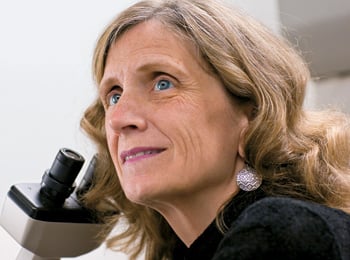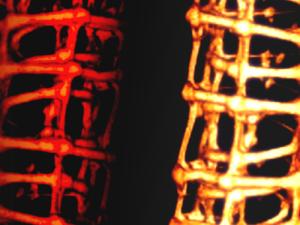Bioengineers at the University of California San Diego have come up with a novel way of removing dangerous toxins from the bloodstream using biomimetic nanosponges. These tiny clean-up particles work by posing as red blood cells, which serves both to evade the body's immune system response to foreign invaders and to attract the toxins to themselves instead of to actual red blood cells. When the toxins have all attached themselves to the nanosponges, they are processed out through the liver without harming the body. The research into this promising therapy comes out of the Zhang Lab in the Jacobs School of Engineering, where in 2011 they pioneered the red blood cell disguise technology for cloaking cancer drug cocktails, allowing the drugs much more time in the body to target diseased cells. Dr. Liangfang Zhang is also on the research faculty of the UCSD Moores Cancer Center.
Tags: 2014, CA, University of California San Diego, 2013, nanoparticle, Nanobiotechnology, nanotechnology, Nanoscience, Southwest, California, University of California, Cell Research, San Diego, SDVS, UCSD, Biotechnology Vendor Showcase
Memorial Sloan-Kettering Cancer Center cell engineering researchers and their clinician colleagues have been in the news recently for a successful experimental cell therapy. Called targeted immunotherapy, a patient's T cells are genetically altered in the lab, then reintroduced with the directive to target and kill cancer cells. The treatment was carried out on a group of adults who all suffered from a rapidly progressing form of leukemia that had not responded to chemotherapy. All five went into remission after the novel cell treatment, and three have stayed that way for a number of months. Results of the ongoing clinical trial appeared in the March 20 online edition of the journal Science Translational Medicine, along with an article in the New York Times.
Tags: 2014, Rockefeller University, 2013, Northeast, Leukemia, immunotherapy, cancer research, New York, Memorial Sloan-Kettering Cancer Center, Cancer Treatment, Immune System, Cell Research, RockU, BioResearch Product Faire Event, NY, New York City, MSKCC
 The tighter funding gets, the more likely it is that young investigators pursuing big ideas will get passed over and science grant money will stay with safer, more established projects. Fortunately there are exceptions to that general rule, including a new program established by the Paul G. Allen Family Foundation specifically to support select pioneering research projects that aim to unlock fundamental questions in biology. They recently awarded investigators from 5 prestigious US universities a total of $7.5M to pursue basic questions about the origins and mechanisms of cellular behavior. One of those 5 Distinguished Investigator awards, for $1.6M, is going to quantitative biologist and recent hire Suckjoon Jun, who works in physics and molecular biology at the University of California San Diego. His project title is "Cell-size control and its evolution at the single-cell level," and includes developing methods to perform long-term directed single-cell evolution experiments, as well as single-cell on-chip manipulation, sequencing, and mathematical modeling.
The tighter funding gets, the more likely it is that young investigators pursuing big ideas will get passed over and science grant money will stay with safer, more established projects. Fortunately there are exceptions to that general rule, including a new program established by the Paul G. Allen Family Foundation specifically to support select pioneering research projects that aim to unlock fundamental questions in biology. They recently awarded investigators from 5 prestigious US universities a total of $7.5M to pursue basic questions about the origins and mechanisms of cellular behavior. One of those 5 Distinguished Investigator awards, for $1.6M, is going to quantitative biologist and recent hire Suckjoon Jun, who works in physics and molecular biology at the University of California San Diego. His project title is "Cell-size control and its evolution at the single-cell level," and includes developing methods to perform long-term directed single-cell evolution experiments, as well as single-cell on-chip manipulation, sequencing, and mathematical modeling.
Tags: 2014, CA, University of California San Diego, 2013, cell biology, Southwest, California, University of California, Cell Research, San Diego, SDVS, Funding, UCSD, Biotechnology Vendor Showcase
Lab scientists at the University of Pittsburgh Cancer Institute and UP's Center for Biologic Imaging have recently published an important paper in the Journal of Cell Science that sheds light on a novel method of interrupting mitosis in a cell by effectively depriving its mitochondria of a key protein. The resulting replication stress means cancer cells are stopped from successfully multiplying. Colorful images of the targeted cells actually show them stuck in anaphase trying to divide and subsequently tearing themselves apart. By identifying a compound that carries out this protein interference and disrupts normal mitochondrial fission, researchers have identified a promising therapeutic avenue for halting cancer growth.
Tags: 2014, 2013, University of Pittsburgh, Pennsylvania, Northeast, Hillman Cancer Center, cancer research, cell biology, Microscopy, UPITT, Cell Research, BioResearch Product Faire Event, PA, NIH, Pittsburgh, Northeast Region
 Researchers trying to find ways to help cure children of disease before they are born with it face an uphill challenge, in part because research on human embryos (even research that might result in a human embryo) is limited by the federal government when federal funding is at issue. Yet progress is being made, notably in the case of mitochondrial diseases passed from mother to child. A gene therapy procedure being studied and tested at Oregon Health Sciences University puts the nucleus of an egg cell with the mother's DNA into the scooped-out mitochondrial shell of another, healthier woman's egg cell. Then the egg is fertilized in vitro and gestated in utero. When research on nonhuman primates three years ago was a success (the monkeys are all alive and well), they tested the basic steps of the procedure with donated human eggs. They brought the hybrid eggs to the blastocyst stage, then cultured lines and did testing on them. At least 20% of the fertilized samples would have been viable for placement in utero.
Researchers trying to find ways to help cure children of disease before they are born with it face an uphill challenge, in part because research on human embryos (even research that might result in a human embryo) is limited by the federal government when federal funding is at issue. Yet progress is being made, notably in the case of mitochondrial diseases passed from mother to child. A gene therapy procedure being studied and tested at Oregon Health Sciences University puts the nucleus of an egg cell with the mother's DNA into the scooped-out mitochondrial shell of another, healthier woman's egg cell. Then the egg is fertilized in vitro and gestated in utero. When research on nonhuman primates three years ago was a success (the monkeys are all alive and well), they tested the basic steps of the procedure with donated human eggs. They brought the hybrid eggs to the blastocyst stage, then cultured lines and did testing on them. At least 20% of the fertilized samples would have been viable for placement in utero.
Tags: Oregon Health Sciences University, Northwest, gene therapy, Oregon, 2012, scientific research, Cell Research, BioResearch Product Faire Front Line Event, OR, OHSU, Portland
 Dr. J. Lee Nelson (right) has been studying the fascinating phenomenon of microchimerism in the context of autoimmune disorders ever since she joined the Fred Hutchinson Cancer Research Center faculty in 1986. Microchimerism refers to the presence of two distinct sets of cells in one individual and is surprisingly common as a result of cell exchange between mother and child during pregnancy. The numbers of these outside cells is typically small, but Dr. Nelson's research has implicated them in various autoimmune responses, both positive and negative.
Dr. J. Lee Nelson (right) has been studying the fascinating phenomenon of microchimerism in the context of autoimmune disorders ever since she joined the Fred Hutchinson Cancer Research Center faculty in 1986. Microchimerism refers to the presence of two distinct sets of cells in one individual and is surprisingly common as a result of cell exchange between mother and child during pregnancy. The numbers of these outside cells is typically small, but Dr. Nelson's research has implicated them in various autoimmune responses, both positive and negative.
Tags: Fred Hutchinson Cancer Research Center, Washington, Northwest, cell biology, 2012, Cancer, Cell Research, autoimmune disease, Canada, Seattle, Biotechnology Vendor Showcase
 It's getting to the point where there's less and less relevant distinction to be made between life science and physical science research. It was clearer when one lab had petri dishes and the other had circuitboards, but what happens when you have both? That's the case in the Harvard University labs of chemist Charles Lieber and his medical school colleague Daniel Kohane, where the bio research team has successfully created living tissue embedded with tiny nanowires capable of running an electrical current so subtle that it does not harm the tissue cells. These 3D bioelectronic structures could potentially both relay complex information about what's going on inside the tissue and receive signals from an outside source such as instructions for repairs. Several news outlets are calling it cyborg tissue and envision its future use in implants, prosthetics, or even some kind of therapeutic microbot. More immediately it will most likely be used for drug testing in labs, as a precursor to animal or human trials.
It's getting to the point where there's less and less relevant distinction to be made between life science and physical science research. It was clearer when one lab had petri dishes and the other had circuitboards, but what happens when you have both? That's the case in the Harvard University labs of chemist Charles Lieber and his medical school colleague Daniel Kohane, where the bio research team has successfully created living tissue embedded with tiny nanowires capable of running an electrical current so subtle that it does not harm the tissue cells. These 3D bioelectronic structures could potentially both relay complex information about what's going on inside the tissue and receive signals from an outside source such as instructions for repairs. Several news outlets are calling it cyborg tissue and envision its future use in implants, prosthetics, or even some kind of therapeutic microbot. More immediately it will most likely be used for drug testing in labs, as a precursor to animal or human trials.
Tags: Northeast, MIT, cell biology, 2012, Biochemistry, Massachusetts, biorobotics, Cell Research, chemistry research, bioprinting, Boston, BioResearch Product Faire Event, MA, Harvard, Harvard Medical School
Research scientists at the University of North Carolina at Chapel Hill have discovered a “spray-on skin” treatment that speeds up recovery in wounds that don’t heal well on their own. The findings, published in the Lancet, showed that ulcers treated with the spray healed better than ulcers treated in other ways. According to WRAL.com, between one and two million Americans have a vein disease where leg wounds have difficulty healing. People with such wounds are at risk for infections and even amputation.
Tags: University of North Carolina at Chapel Hill, North Carolina, Southeast, 2012, Cell Research, Front Line event, NC, research scientists, Chapel Hill, UNC-Chapel Hill, Southern Region
 Oregon State researchers recently discovered DNA in a nematode, a type of roundworm, that may provide an insight into the mechanisms of human aging. The researchers found a specific portion of DNA within the mitochondria of the nematode which displayed the characteristics of "selfish" DNA, in other words, DNA which actually hurts the animal's chances of survival. Scientists have previously found instances of selfish DNA occurring in plants, but this is the first example found in an animal. “We weren’t even looking for this when we found it, and at first we thought it must be a laboratory error,” said Dee Denver, Oregon State associate professor of zoology (photo left courtesy of OSU). "Selfish DNA is not supposed to be found in animals."
Oregon State researchers recently discovered DNA in a nematode, a type of roundworm, that may provide an insight into the mechanisms of human aging. The researchers found a specific portion of DNA within the mitochondria of the nematode which displayed the characteristics of "selfish" DNA, in other words, DNA which actually hurts the animal's chances of survival. Scientists have previously found instances of selfish DNA occurring in plants, but this is the first example found in an animal. “We weren’t even looking for this when we found it, and at first we thought it must be a laboratory error,” said Dee Denver, Oregon State associate professor of zoology (photo left courtesy of OSU). "Selfish DNA is not supposed to be found in animals."
Tags: Oregon State University, Aging, Northwest, cell biology, Oregon, 2012, Cell Research, Genomics, Genetics, current science events, Front Line event, OR, Corvalis, ORSTU, oregon research
Given that the ubiquity of sweat glands over the surface of the body is such a defining aspect of human physiology (and evolution), it's a wonder how little basic research has been done to understand how they work at the cellular level. Until Rockefeller University cell biologists published their recent findings in Cell, we didn't even know if sweat glands had unique stem cells. It turns out they do. The study also demonstrated that, while sweat glands are close cousins to mammary glands, adult stem cell activity is markedly different in the two systems (though they have a common progenitor), and in fact that there are four separate stem cell types that regulate maintenance and repair of glands and their epidermal-level counterparts throughout our lives.
Tags: Rockefeller University, Northeast, Stem cell research, cell biology, New York, 2012, Cell Research, bio research, BioResearch Product Faire Event, NY, New York City

